Last updated: April 3, 2024
Article
These Honored Dead: The Battle of Rivers Bridge and Civil War Combat Casualties (Teaching with Historic Places)
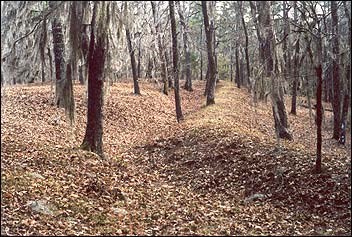
Again at the hospital I see the horrid results of every battle. Men mutilated in every shape conceivable, groaning, begging for assistance and gasping in death. Many of our wounded will have to lie all night in that horrid swamp, it being impossible to find them and carry them out on the narrow foot bridge that has been made. Many have had their heads propped up out of the water where they lay to keep them from drowning.
Lt. Col. Oscar L. Jackson, 63rd Ohio Infantry,
after the Battle of Rivers Bridge, February 2-3, 1865¹
The Civil War is usually studied through major campaigns and battles presented as the maneuvers and clashes of large armies. Lost in this approach is the human element, the effect of the war on the individuals who fought it. Encountering the Civil War on a smaller, human scale makes the conflict more approachable, vivid, and real. Rivers Bridge State Historic Site offers a glimpse of the Civil War on such a scale: Its small area allows one to comprehend the entire battlefield, its tactics, and to see how veteran troops near the end of the war sought to avoid high casualties. The relatively few casualties--most of whom have been identified through historical research--are people, not numbers, and they convey the true human tragedy of this battle and all Civil War battles. Rivers Bridge also serves as an example of how one community remembered its combat casualties after the war--it was through the act of remembering the Confederate dead from the fight that the Rivers Bridge battlefield was preserved.
About This Lesson
This lesson plan is based on the National Register of Historic Places file for Rivers Bridge State Historic Site. It was written by Dan Bell, Historic Resource Coordinator with the South Carolina State Park Service and edited by the Teaching with Historic Places staff. TwHP is sponsored, in part, by the Cultural Resources Training Initiative and Parks as Classrooms programs of the National Park Service. This lesson is one in a series that brings the important stories of historic places into classrooms across the country.
Where it fits into the curriculum
Topics: This lesson plan can be used in teaching U.S. history, social studies, or geography units on the Civil War or the South. It will help students gain a better understanding of the tragedy of war by examining personal accounts of casualties from the Battle of Rivers Bridge.
Time period: Civil War era
United States History Standards for Grades 5-12
These Honored Dead: The Battle of Rivers Bridge and Civil War Combat Casualties relates to the following National Standards for History:
Era 5: Civil War and Reconstruction (1850-1877)
-
Standard 2A- The student understands how the resources of the Union and Confederacy affected the course of the war.
-
Standard 2B- The student understands the social experience of the war on the battlefield and homefront.
Curriculum Standards for Social Studies
(National Council for the Social Studies)
These Honored Dead: The Battle of Rivers Bridge and Civil War Combat Casualties relates to the following Social Studies Standards:
Theme I: Culture
-
Standard B - The student explains how information and experiences may be interpreted by people from diverse cultural perspectives and frames of reference.
Theme II: Time, Continuity and Change
-
Standard C - The student identifies and describes selected historical periods and patterns of change within and across cultures, such as the rise of civilizations, the development of transportation systems, the growth and breakdown of colonial systems, and others.
-
Standard E - The student develops critical sensitivities such as empathy and skepticism regarding attitudes, values, and behaviors of people in different historical contexts.
Theme IV: Individual Development and Identity
-
Standard A. The student relates personal changes to social, cultural, and historical contexts.
-
Standard E - The student identifies and describes ways regional, ethnic, and national cultures influence individuals daily lives.
-
Standard H - The student works independently and cooperatively to accomplish goals.
Theme VIII: Science, Technology and Society
-
Standard A - The student examines and describes the influence of culture on scientific and technological choices and advancement, such as in transportation, medicine, and warfare.
Theme IX: Global Connections
-
Standard B - The student analyze examples of conflict, cooperation, and interdependence among groups, societies, and nations.
Theme X: Civic Ideals and Practices
-
Standard C - The student locate, access, analyze, organize, and apply information about selected public issues recognizing and explaining multiple points of view.
-
Standard E - The student explain and analyze various forms of citizen action that influence public policy decisions.
-
Standard J - The student examine strategies designed to strengthen the "common good," which consider a range of options for citizen action.
Objectives for students
1) To analyze the Rivers Bridge battlefield and describe how its features reveal the soldiers' tactics and their efforts to avoid heavy casualties.
2) To understand the cost of the Civil War in human terms by examining, comparing, and discussing accounts written by and about men who were wounded at Rivers Bridge.
3) To list and explain the main causes for the heavy combat casualties in Civil War battles.
4) To interpret how the Confederate and Union dead from the Battle of Rivers Bridge were later remembered in the community near the battlefield.
5) To research local monuments and discover the impact of war in the students' own community.
Materials for students
The materials listed below either can be used directly on the computer or can be printed out, photocopied, and distributed to students. The maps and images appear twice: in a smaller, low-resolution version with associated questions and alone in a larger version.
1)one map of the battlefield;
2) three readings about the battle, including official casualty reports and contemporary accounts from wounded soldiers;
3) two illustrations of the battle and a casualty;
4) four photos of Rivers Bridge State Historic Site today, including the monument to the Confederate dead, and a photo of a veteran casualty.
Visiting the site
The battlefield and Confederate cemetery at Rivers Bridge are preserved and interpreted today at Rivers Bridge State Historic Site. Rivers Bridge was one of the first historic areas acquired by the South Carolina State Park Service and it remains the only Civil War battle site in the park service. It is located in southern Bamberg County off S.C. Highway 641 and is open daily from 9 a.m. to 6 p.m. For additional information, contact the Interpreter, Rivers Bridge State Historic Site, 325 State Park Road, Ehrhardt, South Carolina, 29081, (803) 267-3675, or visit the park's website.
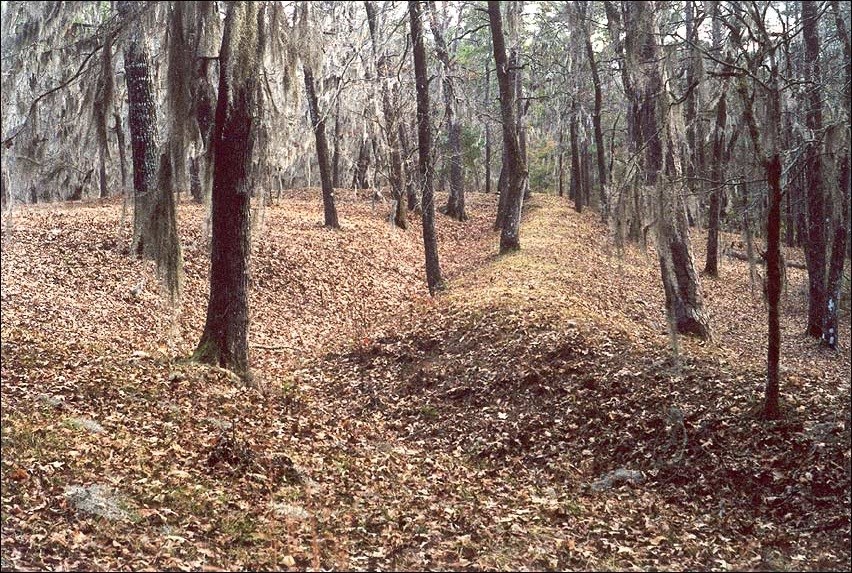
What features stand out in this photograph?
Who do you think made them and why?
Setting the Stage
More than 200,000 men were killed or mortally wounded in combat during the four years of the Civil War; thousands more were wounded and survived.¹ At many Civil War battles huge armies clashed, leaving large numbers of dead and wounded afterward. With such battles it is all too easy to think of the casualties as mere statistics and not as real men who were forever lost to their families or who suffered for years from the lingering effects of horrible wounds.
Not all casualties occurred in large, dramatic battles. In the small battles and skirmishes, where relatively few men fell, it is possible to identify most of the individuals who were killed or wounded and thus see the casualty rate of the Civil War in human terms. One of those small battles took place in a cold, rainy swamp in South Carolina. In early 1865, during the war's final year, an army of 60,000 veteran Union troops led by Gen. William Tecumseh Sherman began a destructive through South Carolina. On February 2 and 3 a portion of Sherman's army attacked an outnumbered Confederate force guarding a crossing of the Salkehatchie River called Rivers Bridge. After one frontal assault failed, the Union commanders decided to go around the Confederate line. Their troops crossed the river and its thick swamp at both flanks of the Confederate position, forcing the Southerners to withdraw.
In two days of fighting at Rivers Bridge, some forty Union and Confederate soldiers were killed or mortally wounded. Another hundred or more suffered wounds ranging from slight to severe. And more than thirty Confederate soldiers were taken prisoner; some would never live to see their homes again.
¹ Patricia L. Faust, ed., Historical Times Illustrated Encyclopedia of the Civil War (New York: Harper Perennial Library, 1991), 448.
This figure does not include the number of soldiers from both sides that died of disease. Many sources say that over 600,000 Americans died in the Civil War.
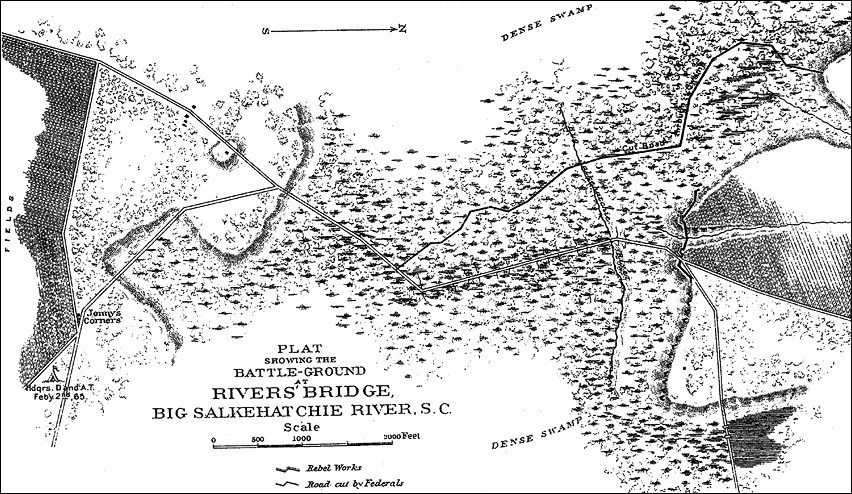
Union troops also crossed the Salkehatchie River several miles below Rivers Bridge. Their movements do not appear on this map.
After the battle the Union commander called the Confederate line at Rivers Bridge "the strongest position I ever saw in my life."
Questions for Map 1
1. Locate Rivers Bridge State Historic Site and the Salkehatchie River on a South Carolina map. Locate Columbia, the capital of South Carolina. With Union troops marching North towards the capital, why do you think Confederate troops defended Rivers Bridge? Why do you think it was important for Union forces to defeat the Confederates at Rivers Bridge?
2. Now examine the physical features of Rivers Bridge as shown on Map 1. Locate the Confederate position (Identified as "Rebel Works," they are between the Salkehatchie River and the open field on the north side.) and the route taken by the Union forces to flank the right end of the Confederate line (shown as "Cut Road Through Swamp" and "Road Cut by Federals").
3. How did the Confederates use the natural features of the site to create a strong defensive position? What difficulties did the Union troops face in attacking this position? What difficulties did they face in going around it? How might the Union troops have used some of the natural features to their advantage?
¹The Battlefield at Rivers Bridge, Atlas to Accompany the Official Records of the Union and Confederate Armies (Washington, D.C.: Government Printing Office, 1891-1895), Plate LXXVI.
Determining the Facts
Reading 1: Surviving on the Battlefield, 1865
New weapons technology and a stubborn adherence to old tactics were responsible for most of the Civil War's casualties. The new technology consisted of the gun most Civil War infantry soldiers carried and its bullets. The gun was the rifle musket, a single-shot weapon that measured almost five feet long and weighed a little less than ten pounds. Inside the barrel of the rifle musket were spiraling grooves called rifling. The grooves caused the bullet--a heavy cylindrical lead slug called a minie ball--to spin as it left the gun. This spinning motion made the bullet travel farther and with greater accuracy.
Rifle muskets, which came into general use only a few years before the war, could kill at three times the range of the older muskets they replaced that lacked rifling. The older muskets fired simple round bullets and were accurate only at short range, so that troops using them had to advance shoulder-to-shoulder to within yards of the enemy and fire in mass in hope of hitting anything. The tactics designed for these earlier weapons did not change after the introduction of the deadlier rifle musket and minie ball. Civil War commanders continued to mass their troops for close-range attacks on enemy positions. These obsolete tactics, combined with the increased accuracy and range of the rifle musket and the minie ball, caused terrible losses during the war.
After several years of combat, however, troops on both sides learned how to better protect themselves in combat. To hold a position against an attack, they fought from behind "works," battlefield fortifications of earth, logs, or fence rails that could shelter individual soldiers or entire armies. In front of works would be various obstacles, such as sharpened branches called abatis (pronounced "aba-TEE," from a French term meaning "to beat down"), to slow attackers and expose them to deadly gunfire. Soldiers learned from hard experience that frontal attacks on the enemy's works cost many lives and often failed. To avoid fortified positions, veteran soldiers would go around one end, or flank, of the enemy's line. This maneuver, called "flanking," would bring attacking troops across the side of their foe, where they could pour gunfire along the exposed line of the enemy and inflict heavy casualties on them or force them to retreat.
On February 2 and 3, 1865, an outnumbered force of Confederate troops delayed the march of a part of Gen. William Tecumseh Sherman's Union army through South Carolina at a place called Rivers Bridge. The Confederate troops who defended Rivers Bridge were veterans; they knew how to choose a good site for defense and make it even stronger. They had fortified a bluff overlooking the Salkehatchie River with earthen trenches and trained their guns on the single narrow road that crossed the thick Salkehatchie swamp. The Union soldiers who attacked at Rivers Bridge were veterans, too, experienced in flanking the enemy out of strong defensive positions. After a frontal assault along the road was repulsed on February 2, Union troops picked their way through the swamp, flanked both ends of the Confederate line, and forced the Southerners to retreat. The Union victory at Rivers Bridge left Sherman a clear path to the state capital of Columbia.
Questions for Reading 1
1. What new technology did Civil War infantry begin using? How was this an improvement over the older muskets?
2. What made combat in the Civil War so deadly?
3. What did Civil War soldiers do to protect themselves on the battlefield?
4. How would soldiers flank an enemy position?
5. What tactics did the Confederates at Rivers Bridge use to defend their position?
6. What tactics did the Union troops use to attack their defenses?
7. Why might Columbia have been an important target for Sherman's troops?
Reading 1 was compiled from J. Tracy Power and Daniel J. Bell, Rivers Bridge State Park Visitor's Guide (Columbia, S.C.: S.C. Department of Parks, Recreation, and Tourism, Division of State Parks), 1992 and other general sources on Rivers Bridge.
Determining the Facts
Reading 2: Casualties in the Battle of Rivers Bridge -- The Official Reports
The Union Report:
Account of Union casualties, from The War of the Rebellion: Official Records of the Union and Confederate Armies, 122 volumes (Washington, D.C.: Government Printing Office, 1880-1901), Series I, Vol. XLVII, Part I, p. 309.
Maj. Gen. F. P. Blair to Army of the Tennessee HQ, "In the Field"
5 February 1865
I have the honor to report the following as the casualties in this command on the 2d and 3d instant, all of which are in the First Division: One officer and 17 enlisted men killed; 3 officers and 103 men wounded. General Mower estimates the losses of the enemy at about 200. There are 16 of their dead on the field and a hospital with 17 wounded found in rear of their position. The number of prisoners taken is 10, and of deserters 17.
The Confederate Report
Account of Confederate casualties, from The War of the Rebellion: Official Records of the Union and Confederate Armies, 122 volumes (Washington, D.C.: Government Printing Office, 1880-1901), Series I, Vol. XLVII, Part I, pp. 1075-1076.Col. George P. Harrison, Jr., 32nd Georgia Infantry, commanding Harrison's Brigade, McLaws' Division; return of Casualties in Harrison's Brigade at Rivers' Bridge, 3 February 1865
I have the honor to report the number of casualties in the detachment from my brigade under command of Lieutenant-Colonel Bacon, Thirty-second Georgia Infantry, in the engagement of the 3d instant at Rivers' Bridge:

Questions for Reading 2
1. Compare the two official casualty reports. Why do you think that the number of Union soldiers killed and wounded was twice the number of Confederates killed and wounded?
2. Note the difference in the number of Confederate casualties estimated by the Union commander and the number of Confederate casualties reported by the Confederate commander. How might you account for the difference?
3. What purposes do casualty reports like these serve to military commanders?
4. If you were an officer commanding a large force of soldiers in the field, how would you report your unit's casualties and the casualties of the enemy? How would obtain your information? How accurate do you think the information would be?
Determining the Facts
Reading 3: Casualties in the Battle of Rivers Bridge -- The Soldiers' Accounts
The Horrid Results of Every Battle
Diary of Lt. Col. Oscar L. Jackson, 63rd Ohio Infantry, from The Colonel's Diary (Sharon, Penn.: N.p., 1922), pp. 177-178:
February 3rd. . . .
9:00 P.M. Again at the hospital I see the horrid results of every battle. Men mutilated in every shape conceivable, groaning, begging for assistance and gasping in death. Many of our wounded will have to lie all night in that horrid swamp, it being impossible to find them and carry them out on the narrow foot bridge that has been made. Many have had their heads propped up out of the water where they lay to keep them from drowning.
Many censure General Mower, commanding our division (the 1st Division, 17th A.C.) for shoving his men against the enemy in such a place, even after he knew the crossing had been made by the other divisions, which he did know, as I was present when a staff officer reported it. He ordered Lieutenant Harrison with a company of the 63rd Ohio to charge along the causeway and with an oath told him not to stop until he got into the enemy's fort. He [Harrison] started, but finding his men being swept off by the enemy's artillery, moved them off the causeway into the water, when finding Colonel Parks of the 43rd Ohio, he received orders from him not to try to go any farther as it was madness. General Howard is said to have criticized the whole of Mower's operation, but it is Mower's style.
Died From Loss of Blood
Memoir of Sgt. John A. Moore, 3rd South Carolina Cavalry, from "A Glance at the Long Ago," Bamberg Herald, April 20, 1905:
I note, in my pocket roll of Co. "C," 3rd S.C. Cavalry, which I carried at the time and still have, opposite the name of John B. Woods, "wounded, February 2, '65." He was shot in the leg in a skirmish with the yankees, just below Broxton's Bridges, and died that night of exhaustion from loss of blood. Dr. Kirkland, our surgeon, said, "he believed he could have saved him if he only had some whiskey." Woods was buried at Rivers' Bridges, where he died. He was a good soldier--one that could be depended upon in any emergency.
During the fight the next day . . . our troops were forced to abandon their position to prevent being taken in the rear by the enemy. One of our squads . . . rode right in among the yankees. Cox and Jim Floyd were captured. Corp'l Ed. Robinson and Spilliards escaped by a bold dash. Robinson received a bullet though the folds of his blanket rolled behind his saddle and into his haversack, where it wadded up in a pair of woolen gloves.
Floyd lived to get home after the war, but Cox, poor fellow, died in a yankee prison.
Bang! I Got it in the Neck
Letter of Capt. Ephraim Wilson, 10th Illinois Infantry, to his wife, from Memoirs of the War, by Captain Ephraim A. Wilson, of Co. "G", 10th Illinois Veteran Volunteer Infantry, In One Volume (Cleveland: W. M. Bayne Printing Co., 1893), pp. 407-413:
Officer's Hospital, Beaufort, S.C. Feb. 9, 1865.
I was wounded at a place called River's Bridge . . . where we were forcing the rebels out of a position they had taken up on the opposite side of the stream. ...On the opposite side they were strongly intrenched. In order to effect a crossing of the stream we were obliged to fall trees across. My Company was the first to cross. As soon as the tree was cut I sprang upon it and crossed and ordered the men to follow. In a moment our whole Company were safely over, and in another they were deployed as skirmishers and were engaging the enemy fiercely. ...I had only fairly got my Company deployed and nicely to work, when bang! I got it in the neck, and fell to my knees in water to my waist. I quickly pulled myself to my feet and took a hurried inventory of the damage done me. The blood was gushing out of my wound in great streams and running into my boots. Knowing that I could not stand this loss of blood very much longer, I sent word of my mishap along the line up to the Orderly who was on the right, requesting him to come and take command. On his arrival I wished the boys God-speed and safety, and tottered back to the log over which we had just crossed and struck out for the shore. The balls were flying thick and fast, and if I had been so unfortunate as to be hit again by the enemy, or had fallen off the log in that deep river it would have been all day with me, as I was so crippled in my arms I could not swim. From the river I moved back to where the Regimental Surgeon was stationed and he staunched the flow of blood, then waded back three miles to the field hospital, in water from knee-deep to the waist. ...they wanted to give me an anaesthetic, but I said, "Go ahead, I can stand it." And so I did, but it hurt me frightfully, just the same, to have that great scraggly minie ball cut out of my back.
Left for Dead
Memoir of Capt. Benjamin S. Williams, 47th Georgia Infantry, from "A Confederate Soldier's Memoirs," Charleston News, March 8, 1914:
At Rivers's Bridge, in the hottest of the fight in the afternoon [Feb. 3, 1865], Capt. Thompson--Joe--went down, a minie ball striking him on the left cheek under the eye and crushing though, came out near the angle of the jaw on the right side of his face. The young captain was left for dead, and was so reported in our "report" of the battle. At our first stop near Branchville, S.C., I kept my promise and wrote to my good friend, Old Col. Thompson, a long letter of condolence and sympathy, informing him of the death of his son, my friend and comrade.
On my first visit to Savannah, after the war, in the fall of 1865, while on my way to call at Col. Thompson's home, I met Capt. DeWitt Bruyn, captain of Company E, of my regiment, and told him of my intended visit and expressed my dread of the meeting the family on account of Joe's death. Bruyn threw his arm around my shoulder and said: "About face and march with me only a block. I want to show you some one and then you can pay your visit to Col. and Mrs. Thompson."
We halted at the open door of an office and Bruyn said: "Go in." I stepped in, a man wheeled about toward me and I stood face to face within five feet of Joe Thompson, ex-captain of Company C, 47th regiment, Georgia volunteers, who had been "killed" at Rivers's Bridge. His face was disfigured and his speech affected, one eye gone, but--there he was. The young captain had, before our retreat, regained consciousness and, one of the favored, had been cared for and removed. He reached Augusta, Ga., and from there, finally, Savannah, and in the chaotic condition of all things, was in his home rapidly recovering when my letter describing his death--reached his family. He had married his pretty sweetheart, Miss Lizzie Gannon, and years after Joe told me that when at home, if feeling kind of blue and reminiscent, he would get out of a safe-keeping place my letter of condolence to his father and read it aloud to his wife and children.
Thirty Years of Suffering
Letter of Frances M. Cherry, from the pension record of Pvt. Edgar W. Cherry, 32nd Wisconsin Infantry, wounded February 3, 1865 at Rivers Bridge, National Archives and Records Administration, Washington, D.C.:
Washington D.C.,
Oct., 12, /97
Hon: Commissioners of Pensions:
Dear Sir:
I wish to have my pension case reopened as I am satisfied that my husband died of his army service just as much as though he died in his bed. He went in to the army in perfect health at the age of twenty-eight, leaving me with two little children. After he came out he never saw a well day; his right eye was put out, his nose shot off, so that he was always obliged to breath through his mouth, which brought on lung trouble. He had frequent hemorrhages and spells lasting two weeks at a time that he could only speak in a whisper. While at the hospital at Madison Wis., the doctors gave him chloform which drove him crasy, so they had to lock him in the operating room for the night with nothing on but cotton drawers and this was in april and he was afterwards three hours at one time and two hours in another, under the surgeon's knife with out taking any opiate whatever. He never recovered from the exposure or shock. His brain was never just right after that. After thirty years of suffering he died leaving me without any means of support. I send two physicians certificates. What more proof do I need to get?
I hope you will give my case your earliest attention, as my little pension is all the support I have.
Respectfully
Frances M. Cherry
#113 Park Place N.E.
My husband served in the Co., A. 32nd Wis., Infantry.
Questions for Reading 3
1. Which would you consider to be more reliable as a source of information, official reports or personal accounts? Why? What purposes do the personal accounts here serve?
2. What was General Mower's "style" discussed in Lt. Col. Jackson's diary account of the battle? What did Jackson identify as the major problem with Mower's style? What effect did it have on his troops? What were the opinions of some of the Union soldiers about attacking the Confederate position?
3. Sergeant Moore's memoir names several men from his unit who were killed, wounded, or captured at Rivers Bridge, but Moore's regiment, the 3rd South Carolina Cavalry, is not mentioned in the official Confederate casualty list. What does Sergeant Moore's account tell you about the difficulties commanders face in getting accurate casualty reports?
4. Captain Wilson, Captain Thompson, and Private Cherry survived the gunshot wounds they received at Rivers Bridge. Note the differences in tone of their accounts. Do they reveal anything about the severity of the men's wounds and how these men were able to deal with them? Might the differences have anything to do with when and for what reasons the accounts were written? When did Ephraim Wilson write his account and who was it for? When was Ben Williams' memoir written and who probably read it? Why did Mrs. Cherry write her letter?
5. Being shot in a Civil War battle was often just the beginning of a long ordeal for the wounded soldier. What were some of the hardships that wounded Confederate soldiers at Rivers Bridge, such as Captain Thompson, had to endure? How would their travails be similar to or different from those faced by wounded Union soldiers, such as Captain Wilson and Private Cherry?
6. What does Mrs. Cherry's letter reveal about her husband's wound and how it affected him years after the war? What do the content and tone of Mrs. Cherry's letter tell you about the toll her husband's wound had on her and her children?
Visual Evidence
Illustration 1: "Sherman's March through South Carolina--Road at the Swamp Crossings."¹
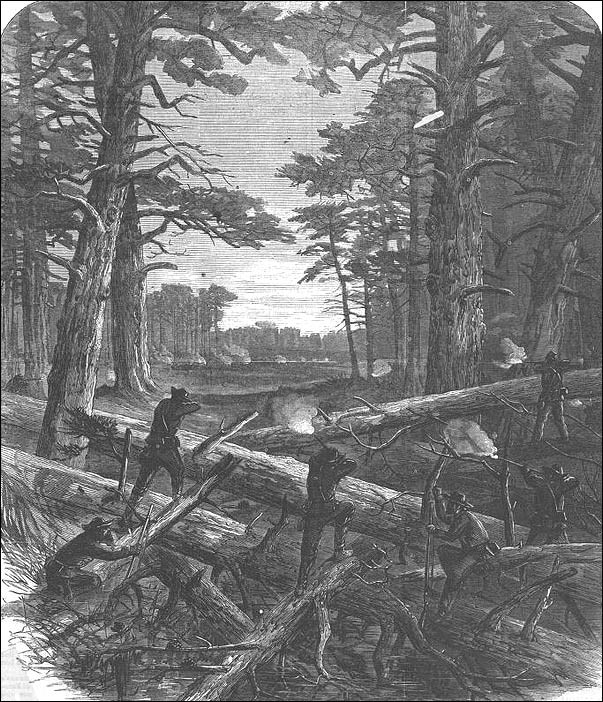
Questions for Illustration 1
1. What does the illustration convey about the fighting at Rivers Bridge? Does the illustration help you better understand what it might be like to fight in such a setting?
2. Compare the illustration with Map 1. What aspects of the terrain does the illustration show that the battlefield map does not?
3. How do Map 1 and Illustration 1 together provide a more detailed depiction of the battlefield and the combat at Rivers Bridge?
4. What might be some of the strengths and weaknesses of fighting in this type of terrain?
¹ "Sherman's March through South Carolina--Road at the Swamp Crossings," from Harper's Weekly, Vol. IX (March 4, 1865), p. 129.
Visual Evidence
Photo 1: The Rivers Bridge battlefield.

(South Carolina State Park Service)
The remains of the Confederates' earthen fortification still stand on the bluff overlooking the Salkehatchie River. The fortifications on the battlefield are preserved as part of Rivers Bridge State Historic Site.
Questions for Photo 1
1. How do you think the battlefield landscape may have changed since 1865?
2. Is it important to preserve Rivers Bridge and other battle sites? Why or why not?
3. How might preserving a battlefield be different than preserving a building or or structure?
4. What special challenges might be encountered in preserving a battlefield with earthworks like those at Rivers Bridge?
Visual Evidence
Illustration 2: Pvt. Edgar W. Cherry, 1865.¹
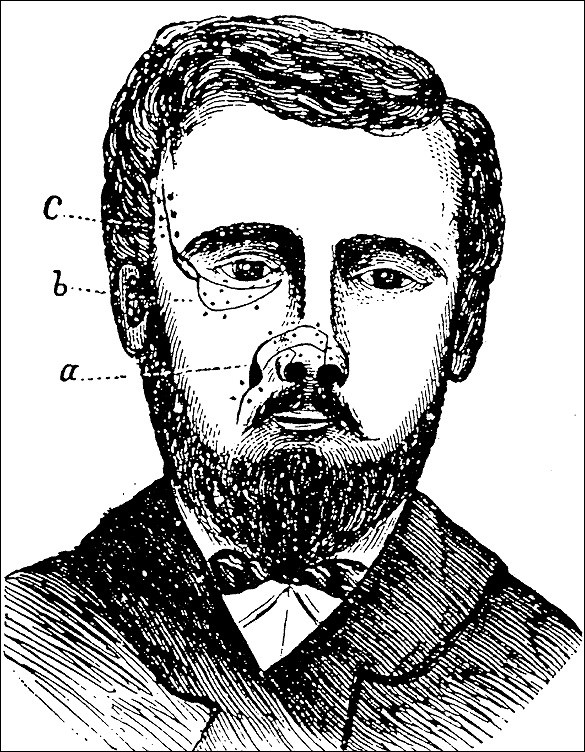
This drawing shows the incisions made by an army surgeon to repair the damage done to Cherry's face by a Confederate minie ball at Rivers Bridge on February 3, 1865. The bullet smashed into his face at his right check and tore out near the bridge of his nose.
Photo 2: Edgar W. Cherry, c. 1890.
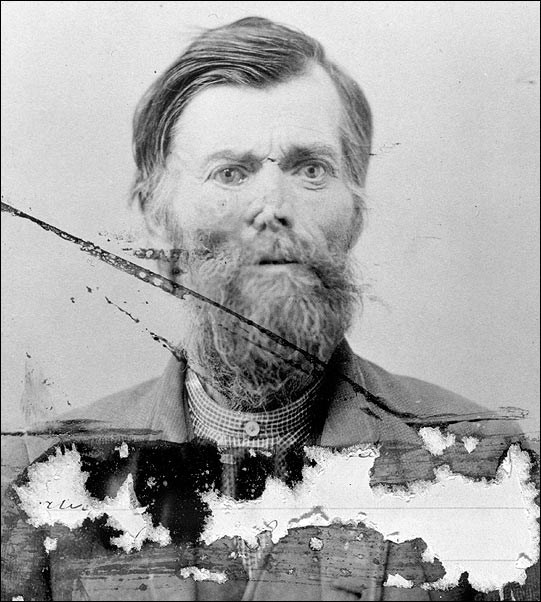
(United States Senate, SEN 51A-E1)
This is one of two photographs Cherry submitted to the Senate in support of his effort to have his military pension increased.
Questions for Illustration 2 and Photo 2
1. Compare and contrast the surgeon's drawing to Photo 2. What does the photograph convey of Cherry's wound that the surgeon's drawing does not?
2. How does the photograph of Cherry compare to Mrs. Cherry's letter describing the effects of her husband's wound?
¹ The Medical and Surgical History of the War of the Civil War (Washington, D.C.: Government Printing Office, 1870-1888; reprint ed., Wilmington, North Carolina: Broadfoot Publishing Company, 1990-1992), Vol. VIII, p. 378.
Visual Evidence
Photo 3: The Confederate monument
at Rivers Bridge, front.
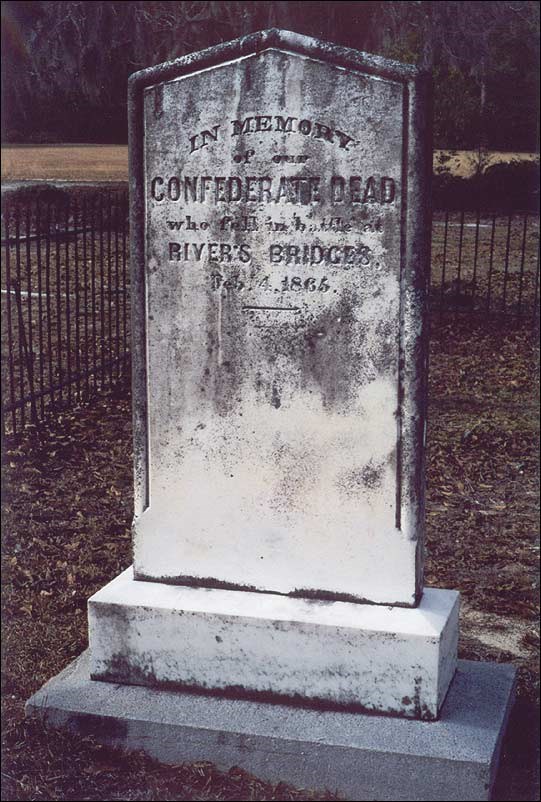
Photo 4: The Confederate monument at Rivers Bridge, rear.
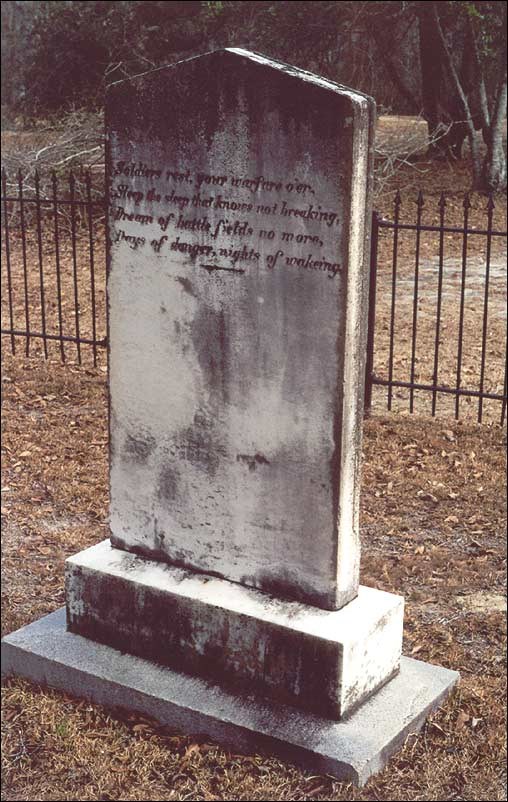
In 1876 the Confederate soldiers killed in the battle of Rivers Bridge were reburied in a single grave near the battlefield. Local people have come to the site every year since then to commemorate the battle and pay tribute to the dead in an annual memorial day service. Like similar services held throughout the country, these memorials recall the sacrifices made by the thousands of men who fell during the Civil War.
Inscription on front of monument:
IN MEMORY
of our
CONFEDERATE DEAD
who fell in battle at
RIVER'S BRIDGES,
Feb. 4, 1865
Inscription on rear of monument:
Soldiers rest, your warfare o'er,
Sleep the sleep that knows not breaking,
Dream of battlefields no more,
Days of danger, nights of wakeing.
Questions for Photos 3 and 4
1. Examine Photos 3 and 4 showing the front and rear of the monument erected in the late 1870s over the mass Confederate grave at Rivers Bridge. Read the inscriptions and look closely at the monument's shape and style. What does the monument resemble? What sentiments does it express about the dead Confederate soldiers? Do you notice anything unusual about the inscription on the front of the monument? (If needed, refer to Setting the Stage to help answer this question.)
2. There is no monument to the Union dead at Rivers Bridge. Why do you think that is so?
3. Do you think it is important for members of a community to commemorate important events that occurred there? Why or why not?
Putting It All Together
The entire country felt the effects of the Civil War. Nearly every community lost fathers, husbands, and sons to battle or disease. Soldiers who were wounded in battle carried the effects of their injuries for the rest of their lives. Many soldiers who survived the years of bloody conflict wrote memoirs and erected monuments to ensure that the war and the sacrifices of the fallen would not be forgotten by later generations. The following activities will help demonstrate to students the effects of war on veterans and the memorialization of these events in their own communities.
Activity 1: Your Account of a Civil War Battle
Civil War battles were noisy, smoky, confusing, and deadly affairs. Have students imagine they are soldiers in a battle and they took wounds similar to Capt. Ephraim Wilson's, or, like Capt. Benjamin Williams, saw a close friend fall wounded, believing him dead. Have them write two brief personal accounts on being a casualty or seeing a comrade become a casualty. They should write the first account as a letter to a family member shortly after the battle (like Wilson's account); then write a second account on the same event as the memoir of an old soldier looking back many years later (like Williams' memoir). Have students read their accounts in class and discuss their differences and why they wrote them that way.
Activity 2: Following the Local Boys Through the War
The Civil War was the single most important event in the lives of most men who fought. It is not surprising that many survivors committed their memories of the war to paper. Either divide students into teams assigning them each a part of this activity or have individual students work on this as a long-term class project. Have students' research and write a history of a local unit. They are to follow the war's course through the actions of the local unit by doing the following: Check the local library for memoirs that were written by local Civil War veterans or a history of a local regiment preferably written by one of its members. Research to see if any local landmarks in the unit's history (a field where the unit first assembled, the site where it received its flag, or the train station where the troops departed for the front) still exist. Locate and trace the different places on a map where the unit was stationed or fought. Write to the battlefields that are preserved as National Parks or state parks for information on the site and your unit's role in the battle. See if the memoirs give any vivid accounts as to what it was like to face minie balls, or if the local unit experienced attacks on fortified positions and then changed tactics as a result. At the end of the war determine the number of men the unit started with and the number of men it finally lost to combat and disease. If possible, locate and photograph the graves of veterans from the unit in the local cemetery. If there is a monument to the unit's service in your hometown, examine and photograph it for what it can tell you about how the community remembered the local boys who served in the war. Students should summarize the findings of their project and share them with the class.
Activity 3: Memories of War
Nearly every community has been affected by war. In your community have students identify a veteran of war or someone who lived on the homefront during wartime and interview him or her as a class project. As a class, have students develop an outline for an interview or discussion questions to ask about that person's wartime experience. They should prepare a written account of the person's memories of war and present the account to the local library or historical society so that it can be preserved for future generations. Following are some suggested questions to help get the interview started: Where was he or she during the war? In which battle did he or she serve? What was it like to serve in the war? What was it like being on the homefront during a war? What does he or she remember most vividly and why? Have students take a photo of the person they interview and include it with a brief biography as part of the oral history they give to the library or historical society.
Activity 4: Monuments
Most communities have also honored the memory of their soldiers who fought in a war. Have students locate soldiers' monument or war memorial in their hometown or county. Then have them prepare a class presentation on it with illustrations or photos. Have students use the following questions for their report: What sort of monument is it--a statue or cannon in front of the courthouse, or a marker in the local cemetery? What inscription does the monument carry--does it name the local men killed in the war or list the various battles they fought in? What feelings are conveyed through the monument--sorrow, pride, defeat, or victory? What can the monument tell you about the community's memory of war and what it meant to recall the sacrifices of the dead? If you were to create a monument to commemorate this event, how would you design it and what would it say? If students find several monuments from different wars, have them describe how they compare to each other.
These Honored Dead: The Battle of Rivers Bridge and Civil War Combat Casualties--
Supplementary Resources
By looking at These Honored Dead: The Battle of Rivers Bridge and Civil War Combat Casualties, students can learn how veteran soldiers adapted to the technological changes that had increased the deadliness of the battlefield, understand the cost of the Civil War in human terms, and appreciate how communities remember history through memorialization. Those interested in learning more will find that the Internet offers a variety of materials.
Rivers Bridge State Historic Site
Visit the Rivers Bridge State Historic Site web page for more information on this South Carolina State park.
The Civil War Preservation Trust
The Civil War Preservation Trust is the country's largest non-profit organization dedicated to the preservation of endangered Civil War sites.
Library of Congress: American Memory Collection
The Library of Congress features a selected online Civil War photograph history in their "American Memory" collection. Included on the site is a photographic time line of the Civil War covering major events for each year of the war.
Tags
- civil war
- civil war history
- civil war battlefield
- civil war battles
- disabled americans
- medicine
- south carolina
- south carolina history
- military history
- national register of historic places
- nrhp listing
- teaching with historic places
- twhp
- veteran
- veteran care in the u.s.
- military wartime history
- mid 19th century
- disability history
- late 19th century
- gilded age
- civil war cemeteries
- twhplp
